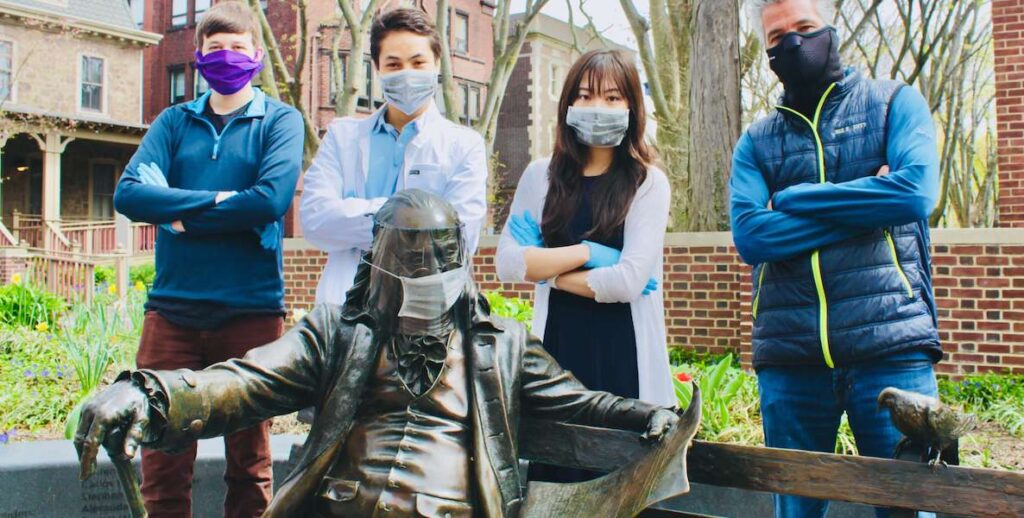Approximately 700,000 people attended the Eagles Super Bowl victory parade in 2018.
John Gamba hopes that even more turn out, when the pandemic is over, to thank our frontline healthcare workers.
“We should have them go down Broad Street, end up at the Rocky Steps, and have more people come out to cheer for these unbelievable people who are doing so much, so selflessly. We really do need to honor them, recognize them and celebrate them,” says Gamba, a 1992 Penn alum and serial entrepreneur who’s currently the first-ever entrepreneur-in-residence at Catalyst at Penn’s Graduate School of Education.
For Gamba, the pandemic is personal: His mother worked as a nurse at the Hospital of the University of Pennsylvania (HUP), and many of his closest friends are nurses and healthcare workers.
“This moment that we face is as [awful] or maybe even worse than what happened on 9/11. It’s tragic to hear and see the pleas from people calling every day from hospitals and on the front lines of what really is a war,” says Gamba.
So he was thrilled and grateful to join more recent Penn alums and entrepreneurs Tiffany Yau, Michael Wong, and Evan Weinstein on Project SHIELDS, an all-volunteer movement based out of Pennovation Works to use 3-D printers to create NIH-approved face shields, 24 hours a day.
Face shields are used as a protective barrier and in conjunction with masks, like the much-needed N95. They serve as a barrier to the droplets or “splatter,” as the Covid-19 particles have come to be referred to.
Like everyone today, the foursome has been horrified by the toll of Covid-19, and how frontline healthcare workers, deprived of essential Personal Protective Equipment (PPE), are risking their lives to help others. So they decided to pool their collective know-how and resources to do something about it.
The team doesn’t care if recipients can pay, or where they’re located, or how they’re struggling. They just want to help.
Within four days of posting a GoFundMe, Project SHIELDS received more than
They have a $10,000 pledge on the way, but emphasize that any amount counts: $20 can cover the cost of as many as 40 shields. Wong and Yau have pulled several all-nighters to staff the machines, but the team is working towards automating them, to relieve that burden.
Several other shield-making endeavors have popped up around the region. James Hartling from Cognizant Softvision is partnering with two Philly local engineers, Omer Dekel of Ontario Systems and Vikram Agrahar of PhillyDIY, to create shields (their GoFundMe lives here). And 14-year-old Louie Beardell has been making them as well.
“We’re really careful about listening to the needs of the people who are on the front lines, instead of just dictating what we think they need. We’re trying to be very responsive to co-construct this approach,” Gamba says.
Project SHIELDS stands out for its capacity, for its adaptability and for its direct access to healthcare workers’ insight: They’re welcoming healthcare workers to Pennovation to try on the shields and give instant feedback, and they’re brainstorming additional ways to support the workers, perhaps by providing disinfectants or parts for ventilators.
“We’re really careful about listening to the needs of the people who are on the front lines, instead of just dictating what we think they need. We’re trying to be very responsive to co-construct this approach,” Gamba says.
They’re also in a wholly sterile environment: Everyone involved in the project—including 10 volunteers, who are taking time away from their day jobs to help—wears gloves and masks; stations are regularly sanitized; and Wong even 3D-printed a device to allow people to open doors without handling knobs.
They’re hearing from physicians, paramedics, technicians, ambulance workers; they’re hearing from New York and Maryland, Massachusettts and California. They want to help as many people as possible, with an extra focus on helping their beloved Philadelphia.
“This is the place that we’ve called home for more than four years now,” says Yau, whose father is a family medicine physician working at four different hospitals in L.A. This is personal for her, too.
“The more money we get, the faster we can scale operations,” says Wong. “We don’t want to get stuck and say If we give 500 here, we can’t give elsewhere.”
Wong is particularly interested in working with a partner who could help them track, in realtime, what the PPE needs are in Philly and around the state. (Calling all data geniuses! Please contact them here!)
And they want to spread the message that everyone has a role to play in fighting this veritable battle.
“It’s the feeling of helplessness that brought me to this project in the first place,” says Weinstein. “I think every single person in Philadelphia has a way to help, whether that’s staying home as much as possible, whether it’s sharing the work of people who are trying to do good work, whether they have the ability to donate. I think everyone is feeling helpless because this is so big, the need is almost infinite. But everyone doing something small really adds up.”
And the sooner we all step up, the sooner we can get past this, and start planning for a much-needed parade of epic proportions.

